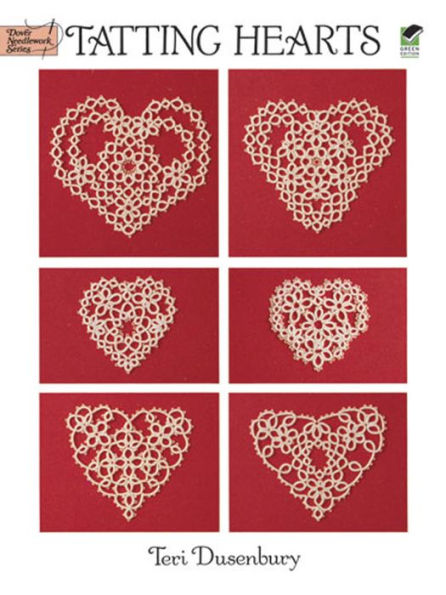Tatting Hearts
Tatting as we know it evolved from knotting techniques dating back thousands of years. The Pilgrims brought the craft to America and today this beautiful and delicate form of lacework is more popular than ever.
This guide to tatting by a veteran needlecrafter provides explicit, clearly written instructions and over 100 illustrations for making 12 different tatted hearts. To create these lovely patterns, the author has developed two new techniques — "directional tatting," a short-cut tactic involving reverse stitches, and "stacking," a method that gives tatting a three-dimensional look. Also incorporated in the patterns is a variation on the split ring technique perfected in the 1920s by the noted designer Anne Orr. Many of the designs are simple enough for a beginner, while others will catch the interest of even the most experienced of tatters.
Perfect as tabletop accents or as framed works of art, each of these completed, lovely heart-shaped designs is shown in a separate photograph. And as an extra bonus, there's a photo of a mobile utilizing all the patterns.
1000122884
This guide to tatting by a veteran needlecrafter provides explicit, clearly written instructions and over 100 illustrations for making 12 different tatted hearts. To create these lovely patterns, the author has developed two new techniques — "directional tatting," a short-cut tactic involving reverse stitches, and "stacking," a method that gives tatting a three-dimensional look. Also incorporated in the patterns is a variation on the split ring technique perfected in the 1920s by the noted designer Anne Orr. Many of the designs are simple enough for a beginner, while others will catch the interest of even the most experienced of tatters.
Perfect as tabletop accents or as framed works of art, each of these completed, lovely heart-shaped designs is shown in a separate photograph. And as an extra bonus, there's a photo of a mobile utilizing all the patterns.
Tatting Hearts
Tatting as we know it evolved from knotting techniques dating back thousands of years. The Pilgrims brought the craft to America and today this beautiful and delicate form of lacework is more popular than ever.
This guide to tatting by a veteran needlecrafter provides explicit, clearly written instructions and over 100 illustrations for making 12 different tatted hearts. To create these lovely patterns, the author has developed two new techniques — "directional tatting," a short-cut tactic involving reverse stitches, and "stacking," a method that gives tatting a three-dimensional look. Also incorporated in the patterns is a variation on the split ring technique perfected in the 1920s by the noted designer Anne Orr. Many of the designs are simple enough for a beginner, while others will catch the interest of even the most experienced of tatters.
Perfect as tabletop accents or as framed works of art, each of these completed, lovely heart-shaped designs is shown in a separate photograph. And as an extra bonus, there's a photo of a mobile utilizing all the patterns.
This guide to tatting by a veteran needlecrafter provides explicit, clearly written instructions and over 100 illustrations for making 12 different tatted hearts. To create these lovely patterns, the author has developed two new techniques — "directional tatting," a short-cut tactic involving reverse stitches, and "stacking," a method that gives tatting a three-dimensional look. Also incorporated in the patterns is a variation on the split ring technique perfected in the 1920s by the noted designer Anne Orr. Many of the designs are simple enough for a beginner, while others will catch the interest of even the most experienced of tatters.
Perfect as tabletop accents or as framed works of art, each of these completed, lovely heart-shaped designs is shown in a separate photograph. And as an extra bonus, there's a photo of a mobile utilizing all the patterns.
4.95
In Stock
5
1

Tatting Hearts
32
Tatting Hearts
32
4.95
In Stock

Product Details
| ISBN-13: | 9780486137971 |
|---|---|
| Publisher: | Dover Publications |
| Publication date: | 02/09/2012 |
| Series: | Dover Crafts: Lace |
| Sold by: | Barnes & Noble |
| Format: | eBook |
| Pages: | 32 |
| File size: | 5 MB |
From the B&N Reads Blog
